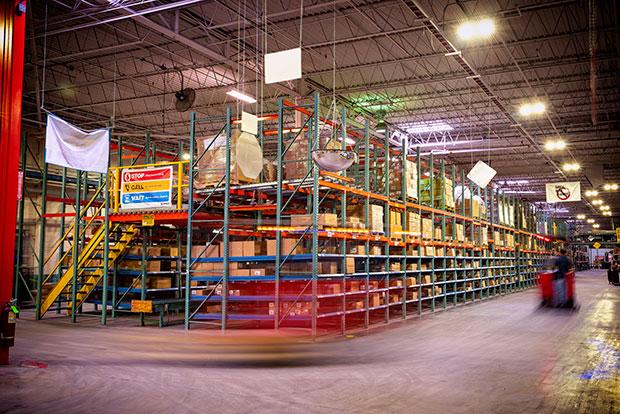Most DCs have designed their processes to optimise picking productivity for fast moving items, the 20 percent of SKUs that account for 80 percent of the picking volume, writes Chandru Palaniyandi, Business Analyst at Lucas Systems. In many cases, a DC will have high-density pick zones or pick modules for these fast movers. By contrast, slower movers are usually dispersed over a larger area, and picking of these items is far less productive and efficient, resulting in higher labour costs per unit. What are some of the ways to address this slow-mover challenge?
 Explaining two-stage picking
Explaining two-stage picking
It’s no secret that if you can move from single order picking to multi order picking, you can reduce the overall number of trips through the warehouse, and as a result, cut significant portions of travel time out of an associate’s day. Among the “lean” tactics to reduce travel in the warehouse, thereby bringing more efficiency to the picking process, two-stage picking is one of the more popular strategies for improving picking efficiency for slow moving warehouse items. In two-stage picking, a worker will pre-pick slow moving items for multiple orders in a batch and place those items near the end of the area where fast movers are picked – this is stage one.
When a worker completes picking the fast movers for an order they are then directed to pick the pre-picked slow movers for the order from the staging location – this is stage two. Two-stage picking can also be viewed as “dynamic re-slotting” (only the items required to fill open orders are picked and moved to temporary locations that are easier to pick from). Batching the slow movers increases pick density and saves significant travel time compared to picking these items by order.
With two-stage picking, picks in the reserve/slow-moving area are separated out from the rest of their assignments and picked ahead of the rest of the assignment. The picker in the reserve area makes one pass through the area making picks for multiple orders, to maximise pick density. Then, they stage those order parts at a staging location at the end of an aisle. In effect, this staging location becomes a second pick location. Now, the pickers picking fast moving SKUs complete most of their picks normally as they are directed to each location. At the end of their assignment, they are directed to the staged pallet/shelf where their slow moving or reserve picks are waiting, and they confirm that they pick up the correct items. DCs using two-stage picking often see double-digit increases in picking productivity for slow moving items.
Best Use Cases for Two-Stage Picking
Two-stage picking is best-suited for large total quantities of orders, generally when the DC has many slow moving and/or diverse SKUs, and the DC ships out a lot of these SKUs on a daily basis, but the quantity per order is very small, and the SKU is very different across orders. The main benefit is that the picker can pick many items from one area at the same time. For example, walking across an aisle just once to grab items for several orders versus walking across the same aisle several times. A large order is split, which helps to minimise travel distance.
It is used quite extensively in the foodservice industry, by Lucas systems customers Kuna and Driscoll Foods, for example. Two-stage picking is actually referred to as PIR (Picks in Reserve) picking in the foodservice vertical. It is also used widely in the Wine and Spirits industry, partially because these DCs have a very large number of slow-moving SKUs that are ordered together with fast-moving SKUs. A typical DC may have only 1000 SKUs in the fast pick area, but 18,000 to 25,000 SKUs in the rest of the warehouse.
Two-stage picking may not be useful if the DC stocks only a small portfolio of slow moving items. Also, if facilities are experiencing some space constraints in the DC, which may not offer enough space to stage pre-picked items, two-stage picking may be difficult to implement.
In conclusion, two-stage picking is a lean tactic that answers the question of how can you organise work in a more intelligent way to minimise the overall effort to get it all done while maintaining quality. Two stage picking does this specifically by significantly improving the picking efficiency of slow-moving items in a warehouse. By pre-picking slow movers for multiple orders and placing them near the end of the area where fast movers are picked, the process reduces travel and increases pick density.
As a business analyst for Lucas Systems, Chandru Palaniyandi optimises warehouse operations and transforms user experience by leveraging his commitment and knowledge in designing innovative solutions that help companies achieve their supply chain goals.
With more than 10 years of experience in the supply chain domain, Chandru started his career as a software engineer building a warehouse management solution for one of the world’s largest sports footwear and apparel brands. That experience has driven a unique ability and insight around warehouse optimisation through effective business processes, labour management, robotics and artificial intelligence.
Chandru earned a Bachelor of Engineering in Manufacturing Engineering from the Guindy College of Engineering and a Master’s degree in Business Information Management & Systems from La Trobe University. Lucas Systems helps companies transform their distribution center by dramatically increasing worker productivity, operational agility, and customer and worker satisfaction using voice and AI optimisation technologies.
Lucas Systems
t: 0289 600 2852




Comments are closed.